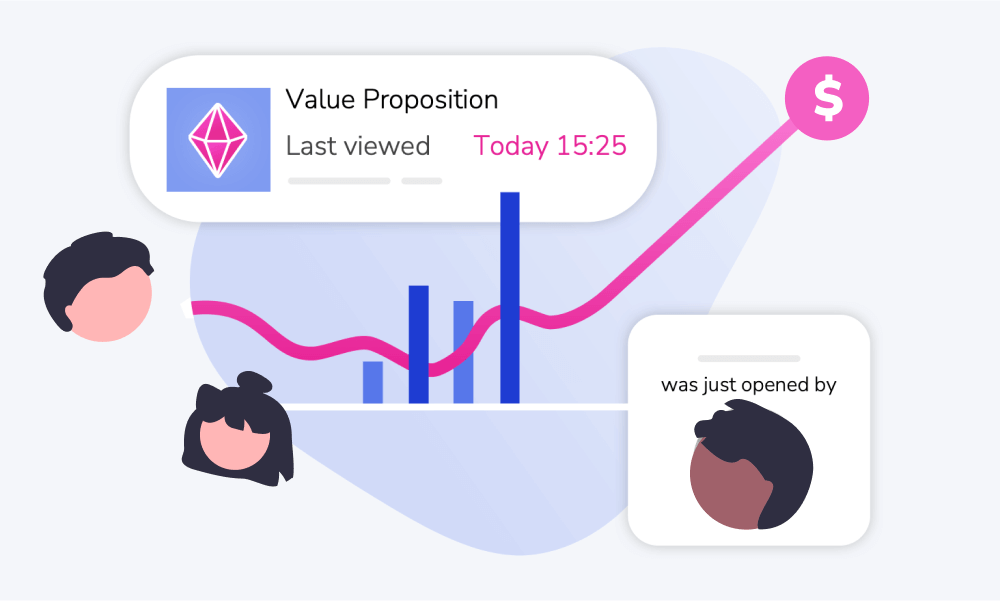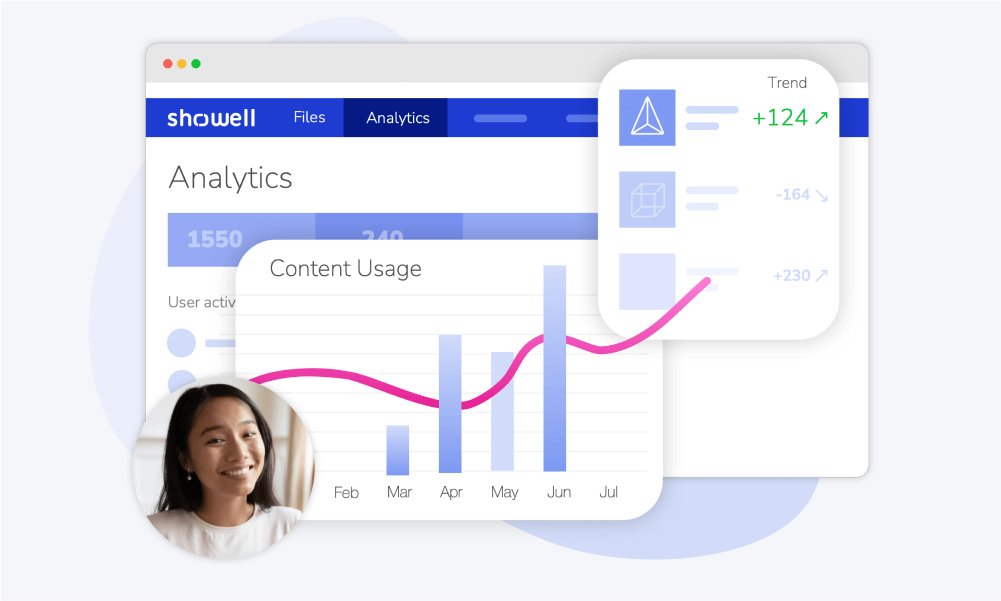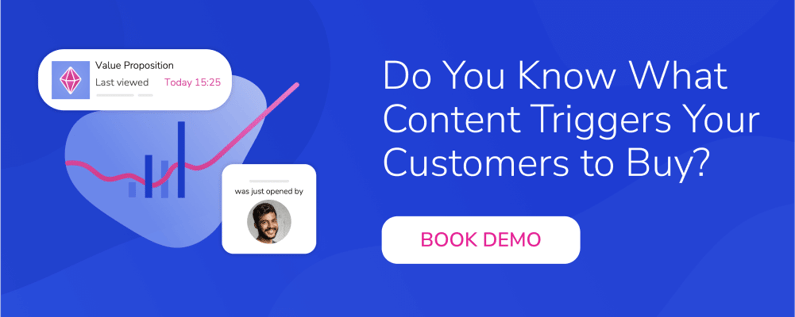A strong sales enablement strategy is just the first step. To maximize sales success, you need to understand the real-world impact your content has. Here's where metrics become crucial.
Without measuring content effectiveness, you're flying blind. You can't identify which resources are driving sales or which need improvement.
Enter the sales content performance dashboard. Fueled by key metrics, it grants you the insights to continuously optimize your content engine. This ensures your sales team has the most effective tools to close deals and propel sales forward.
In this article, we'll delve into the key metrics you need to track to achieve this very goal.
What you'll learn from this blog:
What is Sales Content Effectiveness?
Sales content effectiveness is all about how well your sales materials actually convince people to buy. Effective sales content attracts interest, educates customers, and ultimately convinces them it’s the right choice for their needs.
This can happen in a variety of ways, from generating leads with interesting content to driving sales directly with clear calls to action.
Sales enablement content is key to driving the effectiveness of your sales materials. It goes beyond simply creating brochures and presentations.
It's about understanding how well your content performs in the real world and providing your sales team with the resources they need to succeed. Effective content empowers your sales team to:
Deepen Salespeople’s Product Knowledge
Your content should be a comprehensive resource that allows your salespeople to confidently answer any prospect's questions and showcase the value proposition of your offering. Behind every successful sales rep is a deep understanding of sales prospecting.
Address Customer Pain Points
Don't just talk about features – effective content speaks directly to the challenges your ideal customer faces. It should demonstrate how your product or service is the perfect solution to their problems.
Build Trust and Foster Relationships
Compelling content positions your brand as an authority in its field. This builds trust with potential customers and strengthens your connection with them, making them more receptive to your sales message.
Resonate with Prospects
Does your content resonate with your target audience? Effective content grabs attention, builds rapport, and positions your brand as a trusted advisor.
Drives Conversions
Lastly, your content should ultimately motivate prospects to take the next step. Compelling content should provide a clear call to action, whether it's requesting a demo, signing up for a free trial, or making a purchase.
|
👉 Sales enablement content comprises various materials designed to boost the efficiency and productivity of your sales force. It includes anything from product brochures to case studies, all geared towards one thing: to help your sales team engage prospects and close deals. Learn more about the 7 Types of Sales Enablement Content You Need to Close More Deals. |
Why Sales Content Performance Dashboards Are Essential for Sales Enablement
Content effectiveness goes beyond simply tracking when a sales material is opened. Sales content performance dives deeper, revealing how buyers truly engage with your content.
This empowers you and your teams to truly understand buyer needs and preferences to fuel your sales approaches. You can craft targeted messages that hit buyer needs exactly, refine your sales materials, and even analyze how top performers use content to help others win more deals.
Imagine having a centralized hub that gathers all these valuable insights and presents them in a clear, actionable way. This is where a sales content performance dashboard comes in.
A sales content performance dashboard, fueled by these insights, unlocks valuable benefits for various stakeholders within your sales ecosystem. Let’s break it down by role:
Sales LeadersA sales content performance dashboard allows you to gain a clear picture of buyer needs and preferences to create content that drives conversions. You can use these insights to identify areas where content is successful and where it could be improved. This empowers them to make data-driven decisions about content strategy and resource allocation. For example, sellers can use the dashboard to see which content pieces generate the most engagement at a particular stage of the sales process, so they can include more of that type of content in the future. |
Distributors and Channel Sales PartnersIf your organization operates with a distribution network, channel sales, or partner sales, sales content performance dashboards can help you effectively execute sales plans by understanding how buyers engage with content at different stages of the sales process. You can track dealer activity, identify gaps in plan execution, and see if they're actively promoting your portfolio. Content performance dashboards can also help distributors identify activation gaps and replicate the success of top performers within their networks. 💡 Channel sales can be complex. This guide explores key factors to consider when choosing a platform that strengthens your channel sales foundation.. Here's How to Choose the Right Channel Sales Enablement Platform. |
Marketers and Sales Content CreatorsThis dashboard is not only limited to sales roles! This also supports your marketing teams in optimizing content based on what resonates with buyers and what supports the sales funnel. By analyzing how buyers interact with sales content, marketers gain valuable insights into buyer preferences and purchasing decisions. This allows them to create content that is more relevant and impactful throughout the buyer's journey. For example, the dashboard might show which types of content (e.g., videos, blog posts, infographics) perform best in different regions. This lets marketers tailor their content mix for each area. They can experiment with different content strategies based on what resonates most with local audiences. Analyzing content performance is also an excellent way of ensuring that you’re allocating resources to content that moves the needle. Performance dashboards can reveal content areas that can be discontinued, and those resources can be distributed to the creation of sales material that helps move deals forward. |
6 Metrics You Need To Track in Your Sales Content Performance Dashboard
Building a data-driven content strategy is essential for maximizing the impact of your sales enablement efforts.
As we’ve discussed above, your content performance dashboard unlocks valuable insights that can help you understand how your content is performing at every stage of the buyer's journey.
By tracking the following key metrics within your dashboard, you can gain a comprehensive view of your sales content's effectiveness and identify areas for improvement. Let's get into these metrics to understand how they can guide you in creating a content strategy:
1. Content Usage by Sales Team
This metric focuses on how much your sales team is consuming specific content pieces within the dashboard. It tracks actions like downloads, views, and time spent reading.
High consumption of a particular piece suggests it's a valuable resource for salespeople. Conversely, low consumption might indicate the content is irrelevant, difficult to understand, or not readily accessible.
2. Content Sharing by Sales Team
This metric goes beyond consumption and delves into how salespeople are actively using the content. Does the team frequently share specific pieces with prospects via email or other channels? Are they embedding content like case studies or product demos directly into presentations?
High sharing rates suggest the content resonates with salespeople and is seen as valuable for engaging prospects. Low sharing rates might indicate the content isn't well-suited for specific sales situations or lacks a clear call to action.
3. Content's Impact on Sales Cycle Length
This metric goes beyond just content usage and analyzes how content speeds up the sales cycle. It tracks when prospects engage with specific content pieces within the dashboard and correlates that data with the pace of the sales cycle.
For example, a surge in white paper downloads early in the cycle might indicate prospects are quickly educating themselves, potentially leading to faster sales conversations.
Conversely, a spike in FAQ downloads later in the cycle could suggest potential roadblocks or hesitations requiring salesperson intervention. This insight helps you identify content that streamlines the sales process and allows you to strategically place different content types at optimal points in the buyer's journey.
4. Content Impact on Win Rates
This metric focuses on the specific stages where content plays a crucial role in closing deals. It indicates the stage of the sales cycle when specific content pieces were viewed or shared with prospects.
This reveals which content is most effective at influencing buying decisions. For example, a surge in case study downloads right before deal closure might suggest the case study helps tip the scales in your favor.
Similarly, high engagement with product comparison sheets could indicate content that effectively positions your offering against competitors. By analyzing these content interactions at key conversion points, you can identify which pieces are most influential in closing deals and tailor your content strategy to create more impactful pieces for critical decision stages.
5. Customer Content Engagement
This metric goes beyond basic interactions to measure how deeply customers engage with your content. It tracks specific metrics like time spent on particular pages in a white paper, completion rates for product demos, and frequency of content downloads. Additionally, it analyzes shares and comments on your content.
High in-depth engagement (e.g., consuming entire white papers or demos) suggests the material is valuable and informative. Active sharing and commenting further indicate that customers find the content so compelling they want to share it with others, potentially to other stakeholders and decision makers. This helps you identify content that truly resonates with your target audience and focus on creating more like it.
6. Sales Team Feedback
While the metrics mentioned above provide quantitative data, it's equally crucial to gather qualitative feedback from your sales team through surveys or discussions. After all, they're the ones using the content in the field.
Regularly soliciting their opinions on content relevancy, usability, and areas for improvement can yield invaluable insights.
By effectively tracking these metrics within your content performance dashboard, you can gain a comprehensive view of your sales enablement content's impact and use those insights to strategically optimize your content for maximum sales success.
|
👉 These metrics will provide you with a deeper understanding of your sales enablement content, help drive your sales strategy, and equip your team with the tools they need to succeed. Learn more about Top Metrics to Measure the Impact of Your Sales Enablement Content. |
Optimizing Your Content: Actionable Insights from Your Content Performance Dashboard
Now that you have these metrics handy and know how to analyze each one and their impact, you can ensure your sales enablement content continuously evolves, becoming more effective and aligned with the ever-changing needs of your sales team and prospects.
Here's how to turn those insights into action:
Identify Top Performers and Replicate Success
Analyze which content pieces consistently resonate with your audience. This could be case studies leading to high win rates or white papers with exceptional customer engagement depth (time spent reading, reaching specific sections).
Use your content performance dashboard to identify these winners and use them as a blueprint for creating similar high-performing content.
Revamp or Retire Low Performers
Your sales enablement content strategy shouldn't remain static. The beauty of your content performance dashboard lies in its ability to expose underperformers. These can be identified through metrics like low content usage by the sales team or minimal customer content engagement.
Analyze these to understand why they're falling short. Some content might require a refresh, such as revamping a sales pitch deck with a dated design or unclear value proposition.
Others might be better suited for retirement and replaced with content that better addresses current buyer needs.
Align Sales Content with the Buyer's Journey
Your sales team interacts with prospects at various stages of the buyer's journey. Use your content performance dashboard to identify gaps by analyzing content usage and sales team feedback.
For instance, if feedback indicates a need for more awareness-stage content, you can leverage your dashboard data to see what existing top-performing content types resonate at that stage (e.g., blog posts, infographics) and use that as a guide for new content creation.
Embrace Feedback and Foster Collaboration
Feedback is a goldmine for content optimization. Encourage your sales team to provide input through surveys or regular discussions.
Integrate this feedback loop with your content performance dashboard data to understand the "why" behind usage patterns and engagement metrics.
Additionally, share your dashboard insights with marketing teams to ensure content aligns with broader sales enablement strategy and messaging. This fosters collaboration and streamlines content creation across departments.
Remember, the goal isn't to churn out more content, but to create highly effective content that drives sales. By leveraging your content performance dashboard as a strategic tool, you can transform data into actionable insights and keep your sales content at the forefront of your sales enablement strategy.

Conclusion
Empowering your sales team with the right content is crucial for driving sales success. However, simply creating content isn't enough. You need to understand how effectively your content resonates with your target audience and impacts sales results. This is why your sales content performance dashboard as well as knowing which metrics to track are important.
By leveraging the actionable insights gleaned from key metrics, you can continuously optimize your content, ensuring it remains impactful and strategically aligns with evolving buyer needs. This empowers your sales reps to close deals faster and propel sales forward.
Ready to transform your sales content strategy and unlock its full potential? Book a demo and see first-hand how Showell's powerful content performance dashboard can help you optimize your sales enablement efforts.
Learn more about Sales Enablement:






